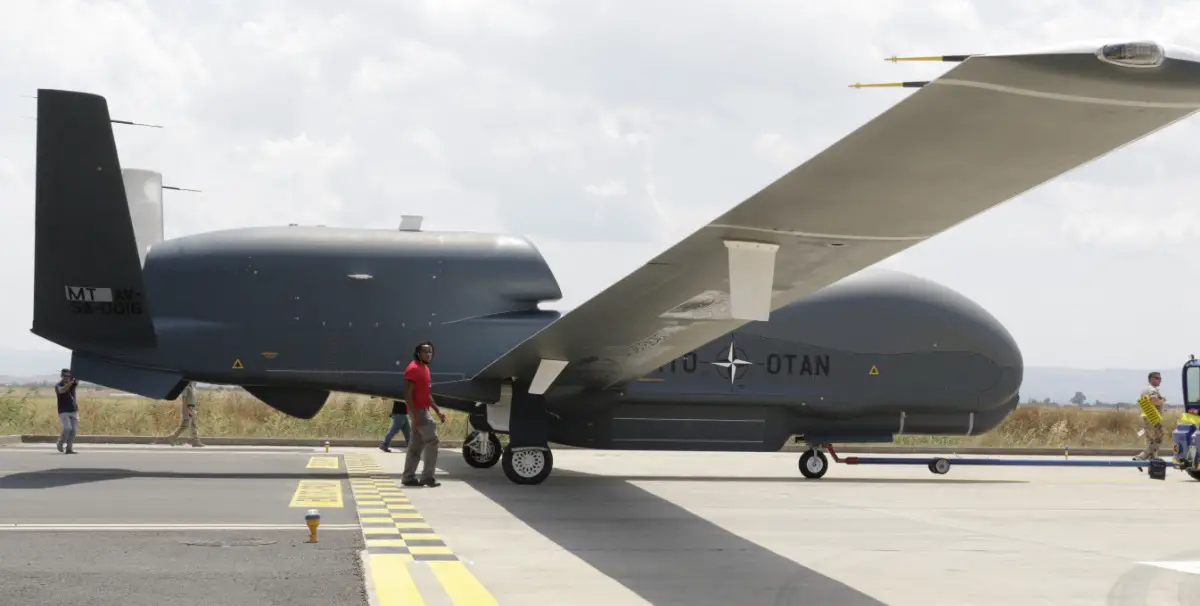On July 15, 2020 the third Phoenix remotely piloted aircraft of NATO’s Alliance Ground Surveillance Programme arrived at 13:37 local time at its new home base in Sigonella, Italy. The landing marks yet another step for NATO on its way to acquiring a total of five RQ-4D remotely piloted aircraft, referred to as “Phoenix”, all to be based at Sigonella. The ferry flight of aircraft NATO-03 from California to Sicily is a significant milestone in the Alliance Ground Surveillance procurement programme. Having now three Phoenix aircraft in Sigonella gives the NATO Alliance Ground Surveillance Management Agency more flexibility in working test and verification issues, by simultaneously providing the equipment for familiarization and training
This latest crossing of the Atlantic from California to Italy was entirely controlled by pilots at the Alliance Ground Surveillance Force’s Main Operating Base in Sigonella, in the same manner as the ferry flight of the first and second Alliance Ground Surveillance aircraft in the end of 2019. The RQ-4D Phoenix remotely piloted aircraft took off on Tuesday, 14 July 2020 from Edwards Air Force Base in California in the United States at 07:47 local time and landed at Sigonella around 21.8 hours later. The RQ-4D Phoenix is now scheduled to undergo a system level performance verification phase before being officially handed over to the NATO Alliance Ground Surveillance Force. Once all five aircraft have arrived at the Alliance Ground Surveillance Main Operating Base in Sigonella by the end of 2020.

The NATO AGS RQ-4D aircraft is based on the U.S. Air Force wide area surveillance Global Hawk. It has been uniquely adapted to NATO requirements and will provide NATO state-of-the-art intelligence, surveillance and reconnaissance capability. This includes protecting ground troops, civilian populations and international borders in peacetime, times of conflict and for humanitarian missions during natural disasters. The Northrop Grumman RQ-4 Global Hawk is a high-altitude, remotely-piloted, surveillance aircraft. It was initially designed by Ryan Aeronautical (now part of Northrop Grumman), and known as Tier II+ during development. The Global Hawk performs duties similar to that of the Lockheed U-2. It can survey as much as 40,000 square miles (100,000 km2) of terrain a day, an area the size of South Korea or Iceland.
In 2009, NATO announced that it expected to have a fleet of up to eight Global Hawks by 2012 to be equipped with MP-RTIP radar systems. NATO had budgeted US$1.4 billion (€1 billion) for the project, and a letter of intent was signed.[110] NATO signed a contract for five Block 40 Global Hawks in May 2012. 12 NATO members are participating in the purchase. On 10 January 2014, Estonia revealed it wanted to participate in NATO Global Hawk usage. In July 2017, the USAF assigned the Mission Designation Series (MDS) of RQ-4D to the NATO AGS air vehicle.The first RQ-4D aircraft arrived at Sigonella Air Base on 21 November 2019. At that time, all five aircraft were undergoing developmental test flights. Initial operational capability was expected in the first half of 2020. In October 2018, Italy certified five of the drones for use in Sigonella, Sicily in 2020.
















